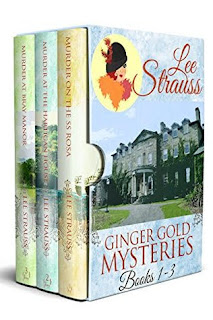Classics Corner: Anne of Green Gables (The Anne Shirley Blythe Series Book One) by Lucy Maud Montgomery; The First and Best Book of Montgomery's Series About The Lovable Imaginative Red Haired Canadian Orphan
By Julie Sara Porter
Bookworm Reviews
Spoilers: Well there are plans and there are disrupted plans. My Reading goal last year was to read and review the books on the PopSugar Reading Challenge for 2020. While I finished reading them in 2020, I hadn't finished writing the reviews. I blame the flu in October and Covid in November for getting me behind schedule (that's bad) and the glut of requested reviews that I had to do first (that's good). But here finally are the final three: The first book that you touch with your eyes closed (Anne of Green Gables by Lucy Maud Montgomery), A book with 20 or more books in the series (The Nancy Drew Mysteries 1-10 by Carolyn Keene) and a book from a previous category-A book you started but haven't finished (The Collected Stories of Franz Kafka). I could give up on them, but when it comes to reading goals, I'm not a quitter!
Well self-pity is over on with the review:
In the book KidLit by Tom Durwood, Durwood found adult themes and analyses in children's literature. One of the examples that he cited was Anne of Green Gables. He saw it as a search for one's identity and belonging and I would have to agree. This book is about Anne Shirley, a young orphan who had been neglected and unloved, though packed with identifiable flaws, and slowly becomes accepted into a family and her community of Avonlea.
I first became acquainted with Anne in the late-'80's during "Anne-mania" when Kevin Sullivan produced two lush, beautiful, and lovely miniseries on the Anne books for CBC (since I'm an American, I saw them on the Disney Channel.) that starred Megan Follows, Colleen Dewhurst, Richard Farnsworth, Jonathan Crombie, and Schuyler Grant. Follows was just lovely as Anne in the role that made her a star.
The first miniseries was based on the first book, Anne of Green Gables and was almost a word for word adaptation. The second miniseries, Anne of Avonlea, was a composite of three subsequent books, Anne of Avonlea, Anne of the Island, and Anne of Windy Poplars.
I also enjoyed the spin-off series, Road to Avonlea starring rich girl, Sara Stanley (Sarah Polley) and her rural family, The Kings headed by her prickly schoolteacher aunt Hetty (Jackie Burroughs). Road to Avonlea was based on Montgomery's anthologies, The Story Girl, The Golden Road, Chronicles of Avonlea, and Further Chronicles of Avonlea. (The first two were not related to Avonlea in book form but were adapted into that universe on television.)
Many Readers and viewers, myself included, were drawn to the beautiful Prince Edward Island, its charming characters, and its almost idyllic dream like portrayal of Canada's past.
When it comes to the book series, the first Anne of Green Gables is the best. Anne of Avonlea and Anne of the Island are also good, though in some cases spend more time developing new characters at the expense of older ones. The later three aren't as well written as though Montgomery grew tired of the series and wanted it to end or lost her knack for writing Anne in favor of her children. However one thing the entire series gets right is how it develops Anne from a young girl into a woman.
The first book does a brilliant job of introducing us to Anne and the world in which she inhabits. Marilla and Matthew Cuthbert, an elderly unmarried brother and sister, are getting on in years. They need some young blood to help them run the farm at their family home of Green Gables in the town of Avonlea. So they decide to adopt a boy from the orphan asylum in Nova Scotia.
In the first three chapters which are titled "(Insert character name) is surprised," local town busybody, Rachel Lynde is, well, surprised. She is miffed that the Cuthberts did not ask her because nothing goes on without her say so. Don't we all know someone like that? That is Montgomery's secret: creating characters that we instantly know and recognize in our own lives, just simply living in 1900's Canada.
Rachel cites gruesome stories about orphan boys setting a house on fire, on purpose and another orphan putting strychnine in a well. "Only it was a girl this time," Rachel said.
"Well we're not getting a girl," says the sharp tongued and severe Marilla. ("as though poisoning a well was purely feminine accomplishment and not to be dreamt of by a boy," Montgomery wryly tells us.)
Cut to the next chapter where, of course, Anne Shirley (always spelled with an e, never without), an 11-year-old orphan girl, sits at the train station waiting for Matthew Cuthbert to arrive and take her to Green Gables. (There was a mix up at the orphanage since the request was sent secondhand, via correspondence).
There are many things that draw the Reader into these books and marks it as a beloved classic. One of those is the description in setting. Nearly every road, stream, or house is described in a lovely enchanting way that turns Avonlea into an almost fairy land, a distant past that is lovely to dream about. In once chapter, Matthew drives his buggy along a road. "It was a pretty road, running along between snug farmsteads, with now and again a bit of balsamy fir wood to drive through or a hollow where wild plums hung out of their filmy bloom," Montgomery wrote, "The air was sweet with the breath of many apple orchards and the meadows sloped away in the distance to horizon mists of pearl and purple; while 'The little birds sang as if it were/The one day of summer in all the year.'"
This is a contrast to other children's classics, say Laura Ingalls Wilder's Little House books, that want to zero in on how hard frontier life was in the past. Montgomery wanted to draw her Readers into this world as much as she wanted Anne to be drawn in.
Instead, it is Anne's old life that is described in muted browns and grays. Her past being raised solely to bring up other people's young children including "twins three times in succession", being abused by adults particularly one foster mother's "drunken husband", and her move to the overcrowded orphanage, are empty and devoid of color. It's a hard world. Anne's only "bosom friends" are her reflection in a glass case, that she dubs Katie Maurice, and her echo in a valley, that she names Violetta.
Green Gables, Avonlea, and Prince Edward Island are constantly described in ways that feel like home. That's the point. It's a place meant to make Anne feel welcome as soon as she arrives and in turn welcome the Readers. It's not a surprise that these books are solely responsible for the increase in tourism to Prince Edward Island. Who wouldn't want to visit these beautiful landscapes at least once?
Besides the attention to detail in setting, what makes Montgomery's books stands out is her lead character, Anne. From the moment that she first appears and greets Matthew at the train station, she makes an undeniable impression. Anne is already introduced as a talkative outspoken imaginative young girl. One of her first monologues takes about a page and a half in which she rhapsodizes about how a tree resembles a bride, then how she imagines that she wears pretty clothes (even though she wears the plain wincey asylum dress) as well as her desire for fashionable clothes, highlights of her boat trip to the island, the questions that she asked her chaperone, Mrs. Spencer on the way over, and her first impressions of the island and its red roads.
This is not a surly argumentative rebellious kid. Instead she is a girl who has a firm hold on her imagination and optimism, as she dreams and hopes for better days.Anne is the type of character that takes delight in the simplest things, like giving objects names (She calls a nearby pond The Lake of Shining Waters), her first taste of ice cream, wearing a dress with puffed sleeves, and finding kindred spirits.
Anne's instantly lovable personality allows her to find kindered spirits everywhere even in the most unlikely of people. She instantly finds one in Matthew during the first ride home when the shy man is amused during her long conversations and realizes that he kind of "likes her chatter." She finds one in Rachel Lynde when after she explodes when Rachel mocks her looks, she makes a melodramatic heartfelt apology which amuses the busybody.
She finds not only a kindred spirit, but a "bosom friend" in Diana Barry, a somewhat wealthy girl who is quieter but willing to go along with Anne's imaginative escapades. She also finds one in Diana's strict mother. Anne accidentally gets Diana drunk when she mistakes currant wine for raspberry cordial and Mrs. Barry orders the two best friends to be separated. She eventually apologizes and becomes another kindred spirit, when Anne's experience with children and quick thinking results in Diana's younger sister from being cured from the croup.
It takes a very long, long time in admitting that Anne finds a kindred spirit in Gilbert Blythe, a boy who pesters her about her looks and earns her long-lived ire. They become academic rivals as the two brightest students in the one-room Avonlea schoolhouse. Later their relationship develops into a friendship and, in subsequent books, a romance and eventual happy marriage.
While Marilla takes some time in admitting it, she becomes another kindred spirit when after she hears about Anne's past, she refuses to surrender Anne to a hardened taskmaster who would also abuse her. Through the book, Marilla goes from feeling sympathy for her charge, to liking her despite and sometimes because of her flaws, to growing fond of her, to considering Anne "dearer to her more than anyone on earth." Anne awakens maternal instincts that Marilla didn't even know that she had.
Part of Anne discovering her own identity and belonging is intertwined in her development and maturity. The majority of the book consists of various scrapes that Anne gets involved in usually concerning follies in hers or other's behavior. One of the first involves a missing amethyst brooch that was a family heirloom of Marilla's. Marilla believing that Anne took it, orders her to stay in her room until she confesses. Taking that punishment literally, Anne creates a confession from her own imagination on which she dropped the brooch into the water below. When Marilla finds her brooch safe and snug on her shawl, they both learn something: Anne not to take things that don't belong to her and Marilla not to jump to hasty conclusions and to believe Anne.
Another lesson cures Anne of her vanity. One of the "crosses that (Anne) bears" throughout her life is her bright red hair. Anyone, like Gilbert or Rachel, makes the mistake of mentioning it will surely receive the the sharp angry end of Anne's mouth. Anne has long wanted to have raven black hair like Diana's (She can't even imagine herself with any other color hair. She can imagine anything else, except her hair is always red.) So she buys hair dye from a shifty peddler which turns her hair green. Humorously, she learns that there are worse things than red hair and eventually grows to accept her hair when it grows to a handsome darker auburn.
However, she never loses her desire for pretty clothes so that later when Matthew, tired of Marilla dressing Anne in the plain clothes that she makes herself, buys fancier fabric and commissions Rachel to make a dress with puffed sleeves. Anne not only cherishes the dress because it's a long sought for dream come true, but recognizes it as a gift of love from Matthew towards the young woman that he always thought of as "(his) girl."
Sometimes Anne's over developed imagination gets her in trouble. One incident, her creation of a haunted wood causes her to fear walking through the woods at night, terrified of the ghosts that she created. Anne is "contented with commonplace places after this". (However, this incident creates long term repercussions with Diana whose imagination becomes underdeveloped because of her fear.) Another incident results in Anne getting lost adrift in a boat while pretending to be the Lady of Shallot. She is rescued by Gilbert (which though she doesn't realize it, leads to her forgiveness for his long ago taunting), but believed that this incident which left her cold, drenched, and embarrassed cured her of her desire for romance. However, her imagination and romance never dies as throughout the series, as she develops a talent for writing and finding beauty, adventure, and more kindred spirits in the most comnon of places and situations.
Anne is a girl who is looking for a place to belong and she finds that in Green Gables. Before she considered herself "Anne from nowhere and belonging to nobody." She accept being a part of a family and her life as "Anne of Green Gables" ("which is better than being Anne from nowhere".) At first, she is seen as an outsider, a strange girl with a bad temper who goes on weird tangents. Then her circle grows wider as she becomes a schoolgirl and church member with many friends her own age.
Though she thinks the pastor's sermons are too long and boring and doesn't like the first teacher Mr. Phillips, who makes eyes at one of the older students, Prissy Andrews. She later bonds with the new minister and his wife, the Rev. and Mrs. Allen, as well as the schoolteacher, Miss Stacey. The Allens and Miss Stacey become guides that help Anne on her path.
As Anne matures, she hones her interest in literature, composition, and imaginative situations into academic success. She becomes an honor student and gets accepted into Queen's College winning a scholarship for Arts students. Despite great tragedy in her family, she is able to forge ahead on her path and become an important member of her community.
Later she becomes a schoolteacher, a member of the Avonlea Improvement Society, a student at Redmond University, a high school principal, a wife to Dr. Gilbert Blythe, a mother of five, and eventually a writer of short stories and novels, first of romantic love stories then more realistic ones that depict fictionalized versions of her childhood experiences.
Symbolic of Anne's growing influence as a fulfilled woman who is aware of her personal identity and involvement in her growing communities is the change in titles throughout the series. Anne of Green Gables depicts her family home and close friends and family. Anne of Avonlea causes the circle to spread throughout the town as we see her as a schoolteacher and townsperson, getting to know her pupils, their families, and other townspeople and neighbors. Then it grows even wider to Anne of the Island (as in Prince Edward Island) as Anne explores university life with her fellow classmates, gets involved in romance with Gilbert and another man, and even in one of the best chapters visits the home in which she was born and reads love letters between her deceased birth parents. Eventually, Anne leaves the island to settle in towns like Windy Poplars and Ingleside, creating an even larger connection that extends throughout Canada.
It's clear that in the 112 years since she was first created, Anne Shirley has found kindred spirits in many of her Readers. Far from unloved or unaccepted, she is "Anne of Everywhere."







